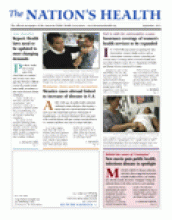Public health laws in many parts of the United States are outdated and, in some cases, leave gaps that will make it difficult to move the country toward better health, according to a June report from the Institute of Medicine.
“Public health law is still quite ancient and inconsistent,” said Lawrence Gostin, JD, a professor of global health law at Georgetown University and a member of the report’s authoring committee.
The report recommended updating public health laws to reflect present-day concerns and the ability of governmental public health to respond to those threats using the best scientific evidence that is available.
Among other recommendations, the report calls for accreditation of state and local health departments, access to dedicated governmental legal counsel with public health expertise and the ability to use the courts to enforce public health and safety standards when necessary.
As an example of the need for changes to public health law, the report cites a case study of states trying to enact public health reform. During one of two attempts in Alaska, the study said, officials wanted to reform laws in the face of the threat posed by Severe Acute Respiratory Syndrome but ran into roadblocks at first because they were unable to find support among those with the necessary political capital. In South Carolina, public health leaders did not want to risk endangering existing authority by trying to enact more specific laws, the study said.
Gostin said the nation’s public health laws are not all bad — in fact some parts are very good — but they were created sometimes decades ago in response to public health concerns such as sexually transmitted diseases and tuberculosis that are no longer the biggest threats to the nation’s health.
“Generally, these laws really say very little about modern crises like diabetes and obesity and heart disease,” Gostin told The Nation’s Health. “They really predate the epidemiological transition we’re experiencing.”
The law can play a key role in making people’s lives healthier, Gostin said, and the report seeks to illustrate ways that government can use legal tools to deal with the health problems facing the country today.
“What the health sector does to improve health only has a very small total impact on health,” said Gostin, who is also director of the O’Neill Institute on National and Global Health Law. “What is much more critical is what other agencies do.”
Such a health-in-all-policies perspective urges governments to look to all sectors, including transportation, energy and agriculture, as well as taxation and revenue for creative ways to improve health. Almost any policy created by the government can have a health impact, he said. For example, corn subsidies support the production of inexpensive corn sweetener. Subsidizing healthier fruits and vegetables instead would make those products less expensive and more available to the public, Gostin said. Making cities more walkable through transportation policy will encourage people to get out of their cars.
Marthe Gold, MD, MPH, chair of the Department of Community Health and Social Medicine at the City University of New York Medical School and chair of the committee that authored the report, called the recommendation for adopting an intersectoral approach to public health “groundbreaking.”
“In sectors where health might not be the first thought to cross someone’s mind, this has the ability to have a profound impact,” said Gold, who is an APHA member.
Among the most high-profile recommendations of the committee contained in the report is the suggestion that states revise their laws to require public health accreditation for state and local health departments through the Public Health Accreditation Board process.
Public health accreditation for health departments will launch this fall and will be voluntary. Committee members acknowledge that it will be quite a change to require accreditation, but said they feel it is crucial.
Gostin said accreditation is a method of quality control that will ensure that public health providers are able to deliver the 10 essential public health services, another recommendation of the committee. Those 10 services include monitoring health status to identify and solve community health problems; diagnosing and investigating health problems; informing, educating and empowering people about health issues; developing policies and plans to support community health efforts; enforcing laws and regulations; and assuring a competent public and personal health care workforce.
“Public health needs to professionalize itself in order to advance itself and gain legitimacy and authority,” he said.
Several committee members noted that smaller public health agencies and jurisdictions will have difficulty achieving accreditation and meeting the proposed requirements for delivering the 10 essential services.
“For many jurisdictions, that’s going to be a very high bar,” said committee vice chair Steven Teutsch, MD, MPH, chief science officer at the Los Angeles County Department of Public Health. “Many jurisdictions will not be able to achieve it because they won’t have the resources.”
The solution, he told The Nation’s Health, may be reorganization. Smaller jurisdictions may need to combine with others and pool resources as a way to operate more efficiently and ensure their ability to deliver the 10 services.
Knowing that mandatory accreditation will be an uphill battle for many jurisdictions and wanting to allow time for reorganization and rethinking the status quo, the committee put a long timeline on that goal, recommending that the requirement be in place by 2020.
The report is the second authored by the committee at the request of the Robert Wood Johnson Foundation. The first examined various methods of measurements and assessment that can be used to summarize the impact of a policy or program on public health. A third report will develop recommendations for funding state and local health systems that support the needs of the public after health reform.
The committee acknowledged the importance of funding as one of the key recommendations in the recent report, saying that states need to ensure that public health agencies have “the mandate and the capacity to effectively deliver the 10 essential public health services.”
Robert Pestronk, MPH, executive director of the National Association of County and City Health Officials and an APHA member, said the third report will be essential to realize the goals set forth in the first two reports.
“It’s one thing to make recommendations, it’s another thing to have the financial wherewithal to make those recommendations real,” he told The Nation’s Health.
Pestronk and those on the committee said they expect the recommendations in the report will be adopted and implemented gradually over time in different ways and places, but all agreed that they are necessary to move public health toward the future.
The bottom line, Gostin said, is that it is time for public health to “go beyond the bitter infighting” to assure quality in all sectors of public health.
“Public health doesn’t want to be left behind,” he said.
For more information or to download a copy of the report, “For the Public’s Health: Revitalizing Law and Policy to Meet New Challenges,” visit the Institute of Medicine website at www.iom.edu.
- Copyright The Nation’s Health, American Public Health Association









